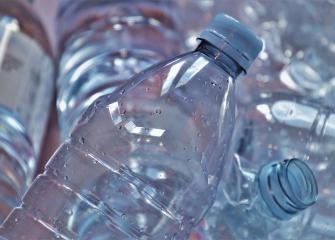Aiming for a breakthrough in the circular plastic economy

Plastic has proven to be a serious problem when it enters the environment. It breaks down very slowly in nature and breaks down into tiny pieces, known as microplastics. These can enter organisms in the food web and can eventually also end up in the human body. Plastic can leach chemical compounds, some of which are harmful to the environment and health. Animals can also become entangled in plastic objects and fibrils and swallow large pieces of plastic with potentially fatal consequences.
Plastics are primarily produced from petroleum derivatives, making the plastic industry a part of the fossil fuel economy. Plastic waste enters the environment from various sources, including consumer products, construction, road transport, shipping and fishing. The majority of the plastic waste that end up in the environment originates from land-based sources and is transported to water bodies through rivers and stormwater runoff.
Much plastic waste still ends up in the Baltic Sea
Plastics are the most common type of marine litter. There are usually dozens, sometimes hundreds, of pieces of plastic per 100 metres of Finnish coastline. Their sizes vary from small plastic shreds and cigarette filters to large plastic bags and boxes. Microplastics have been found in both the Baltic Sea and inland waters.
Plastic packaging is still poorly recycled
A significant proportion of plastic waste is packaging waste. Approximately 370,000 tons of plastic packaging waste was generated in 2019. This figure includes households, offices and other municipal waste generating activities. In addition to this, plastic packaging waste is generated in industry, agriculture and construction. Around one third of plastic packaging is recycled, the rest is incinerated, i.e. recovered as energy. The most efficiently recycled items are plastic bottles with a deposit system; their return rate is over 90 percent.
Recycling of packaging plastic waste is becoming more efficient
The European Union's recycling target for plastic packaging waste is 50% by 2025 and 55% by 2030. This is also the target in Finland. The recycling of packaging plastic waste from households has already accelerated since plastic collection bins became mandatory for properties with more than five apartments in 2021. Agencies, services, and businesses located in urban areas are also now required to separately collect plastic waste.
Plastics can be recycled mechanically or chemically
Plastic waste is currently recycled primarily through mechanical means, meaning that plastic is sorted, washed, melted, and granulated to be reshaped into new forms. Plastic can also be recycled chemically, and methods for this have been developed in Finland. In chemical recycling, plastic is processed and broken down into simpler molecules, which are used as raw materials for new plastic. The first facility in Finland started operating in the fall of 2023. This enables the expansion of plastic recycling to all types of plastics, including composite plastics.
Single-use plastic products are being restricted
In Finnish legislation and the national waste plan until 2027, the goal has been set not only to increase plastic waste recycling but also to reduce the use of single-use plastic products. This objective is in line with European Union regulations, which ban or impose various restrictions on some single-use plastic products. The tobacco industry is required to contribute to cleaning costs because cigarette butts are the most common plastic litter found in the environment. Alternative materials and solutions are also being developed for plastics.
Plastics roadmap points the way towards a sustainable plastics economy
A broad working group assembled by the Ministry of the Environment has developed a roadmap for Finland towards a sustainable circular economy for plastics. The roadmap sets out ways to reduce the negative impacts of plastics, avoid unnecessary consumption, improve the recycling of plastics and find substitute materials and applications. These actions cover the entire plastics value chain, from product design to plastic waste. The aim is to achieve a breakthrough in the circular economy of plastics in Finland by 2030.

